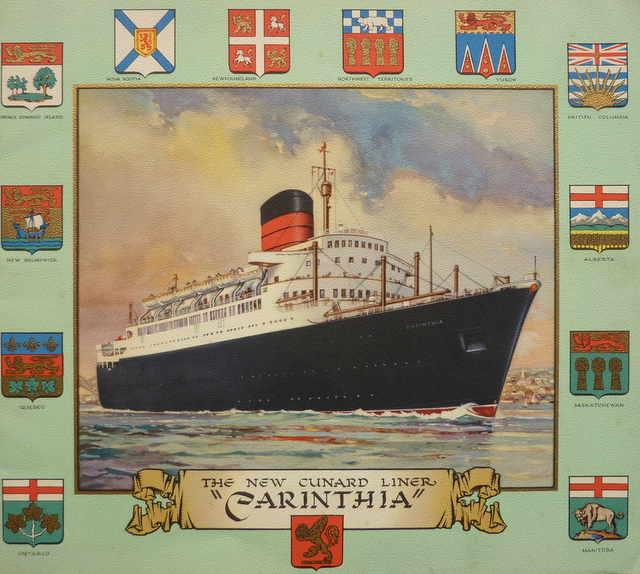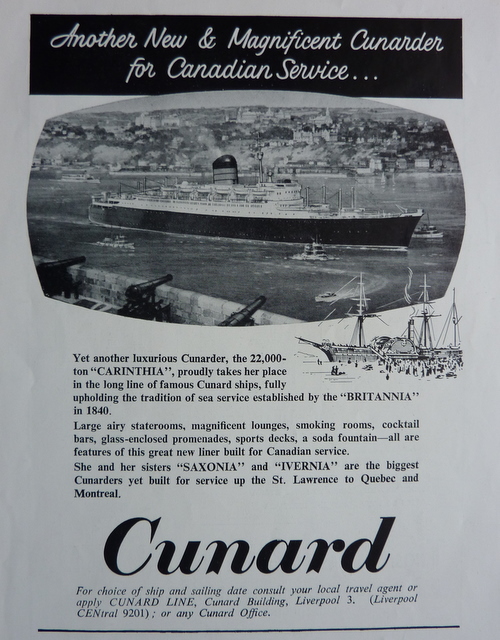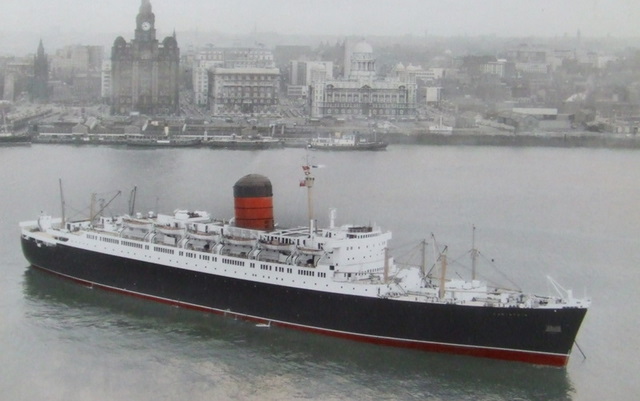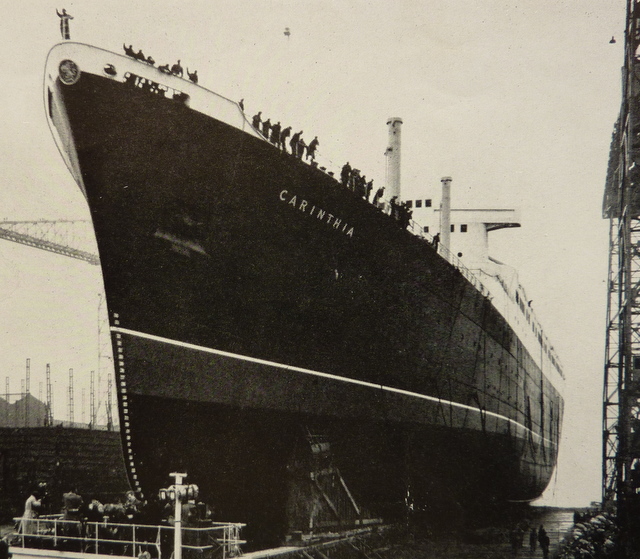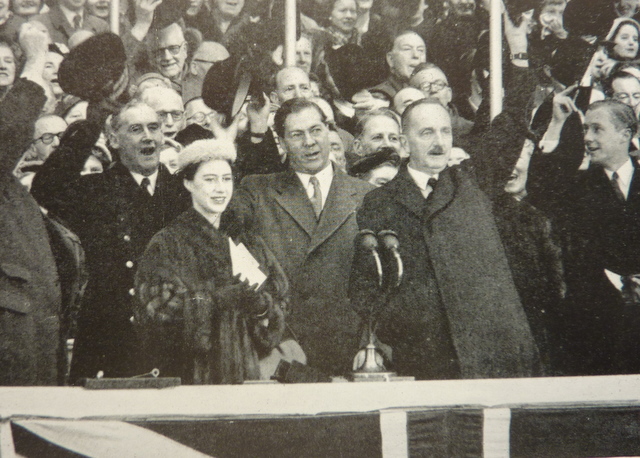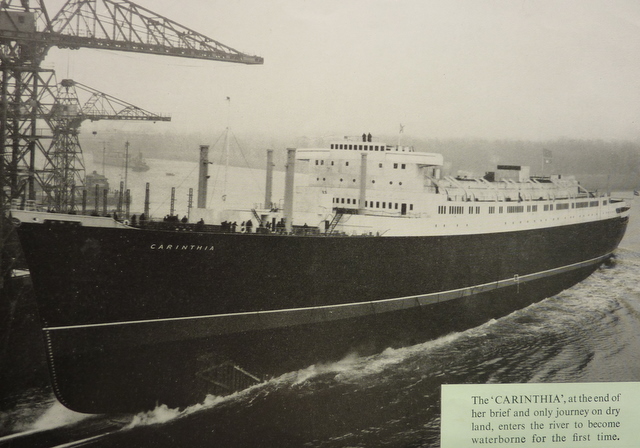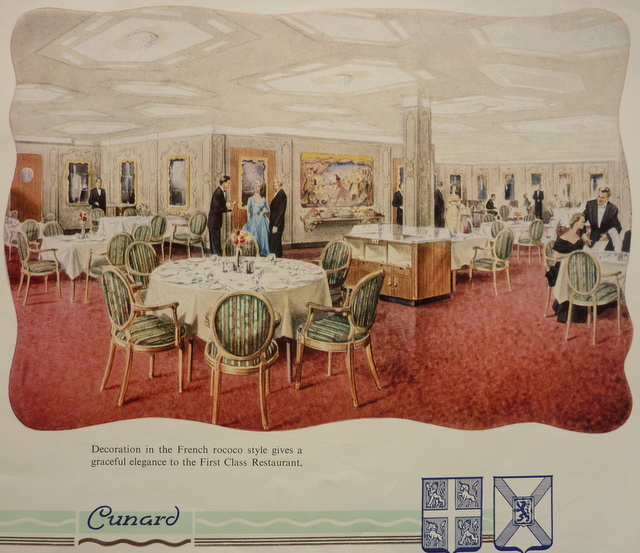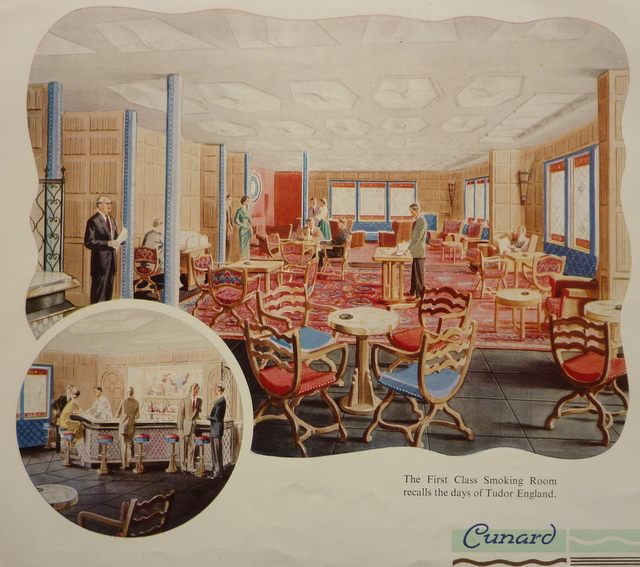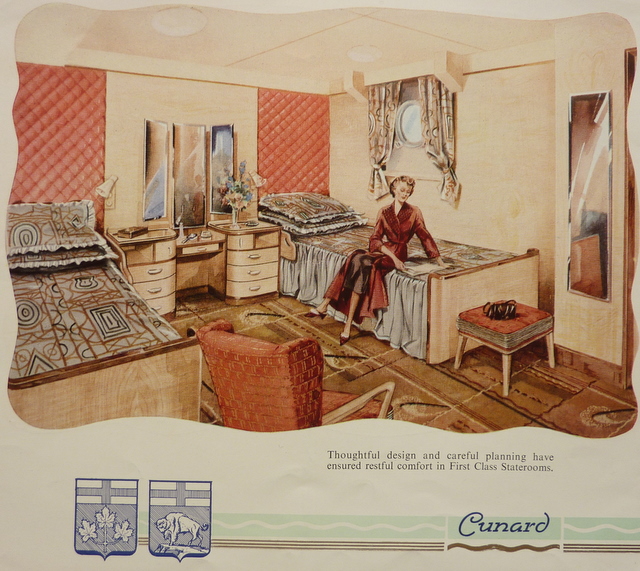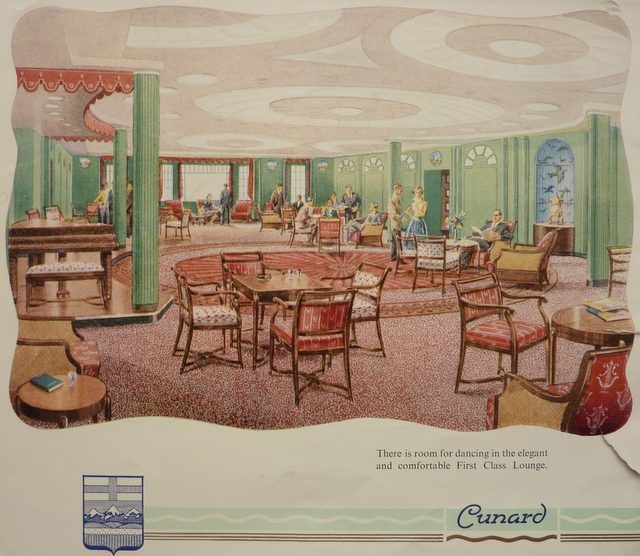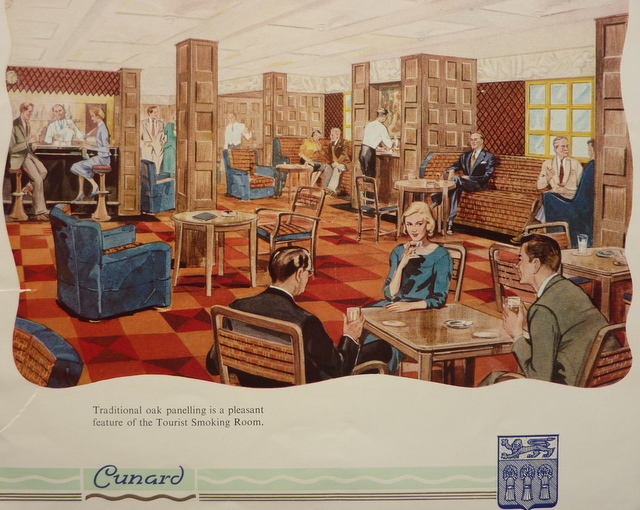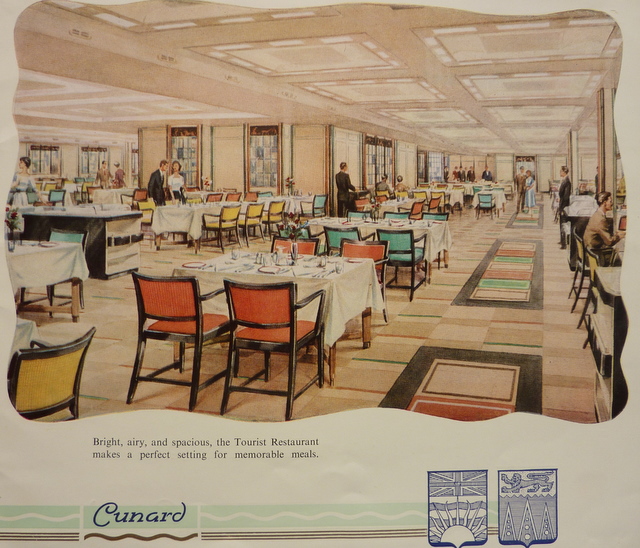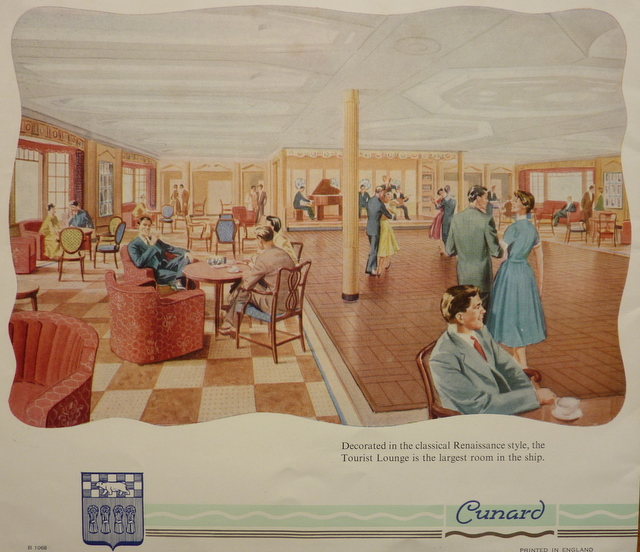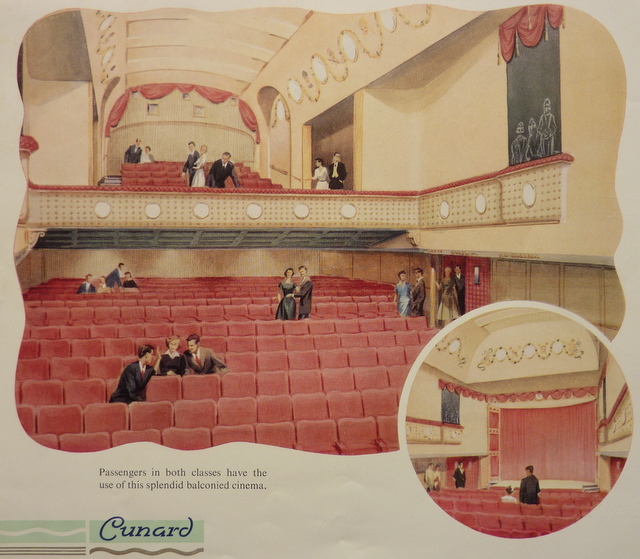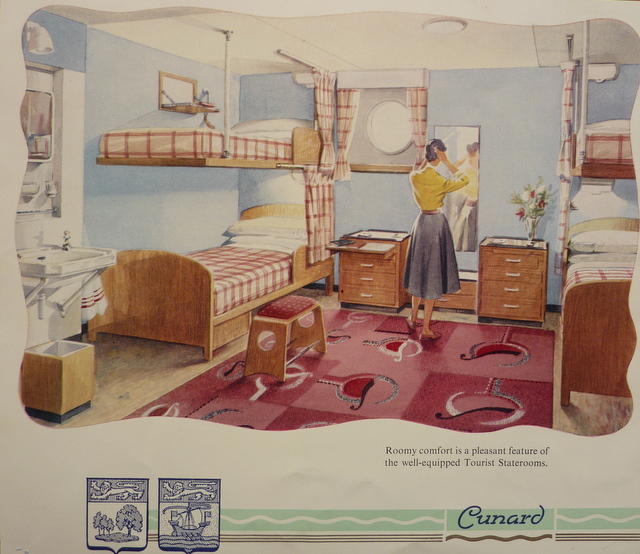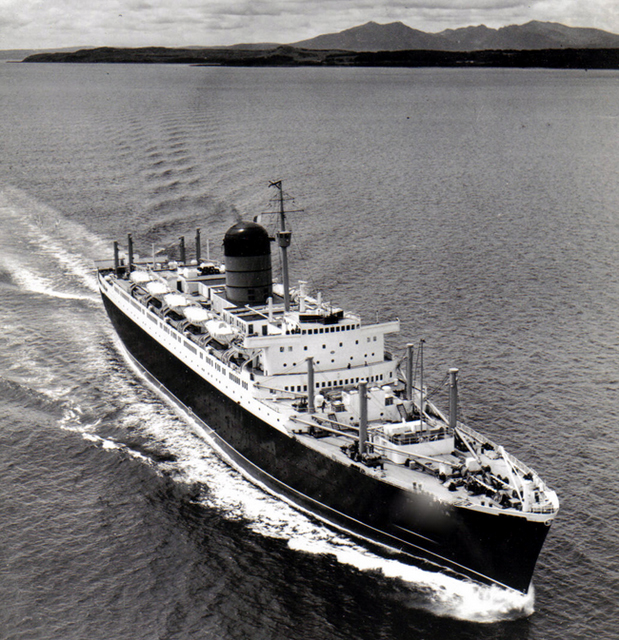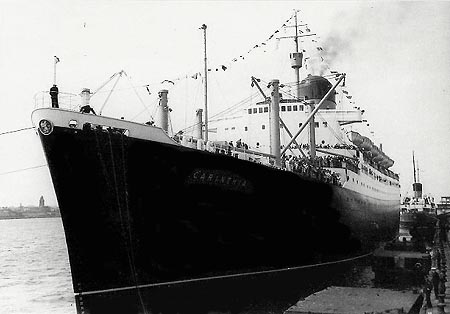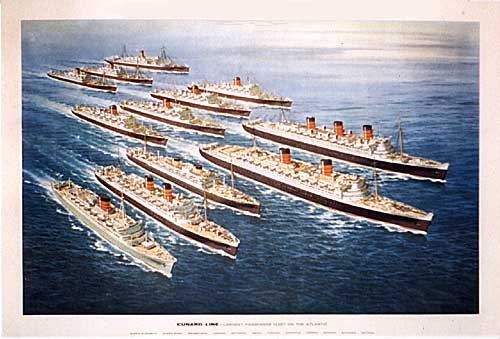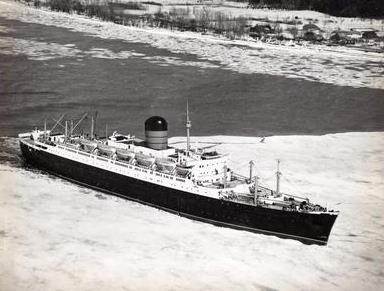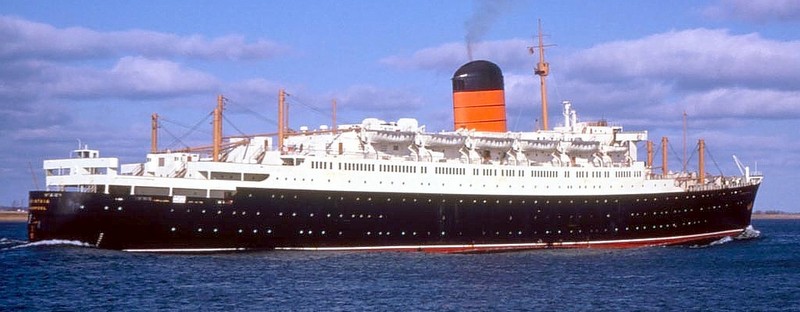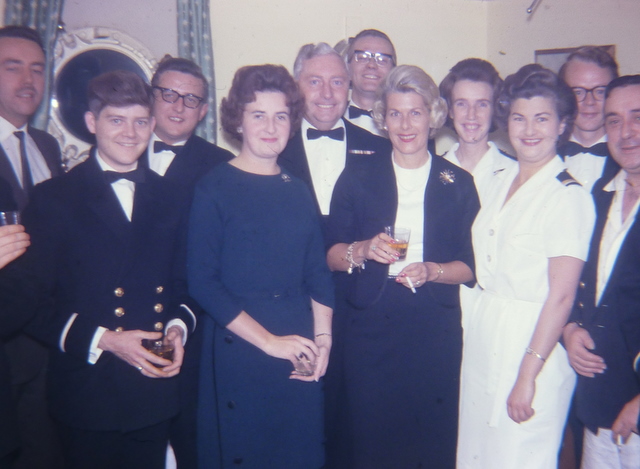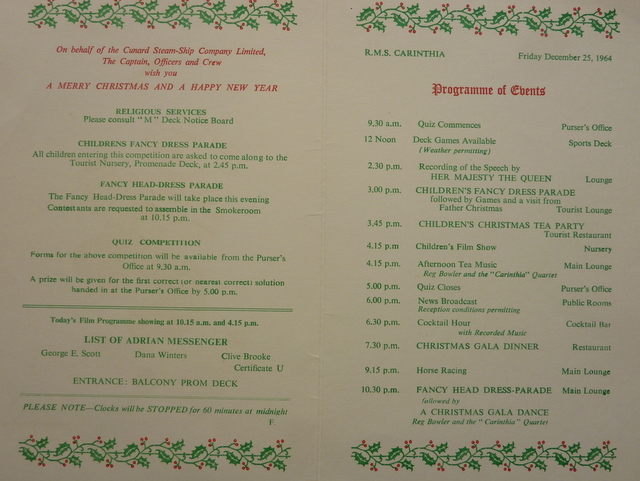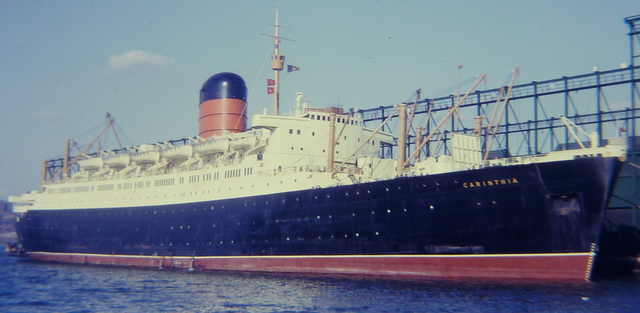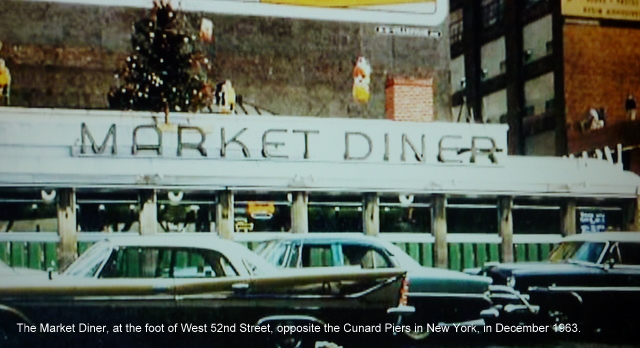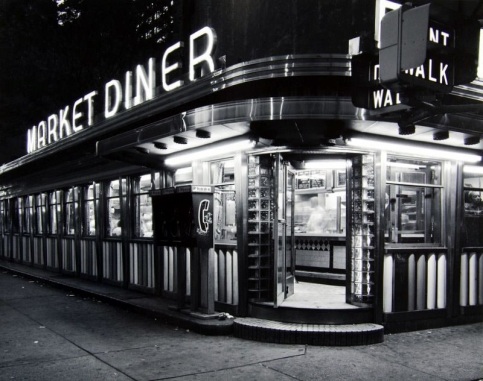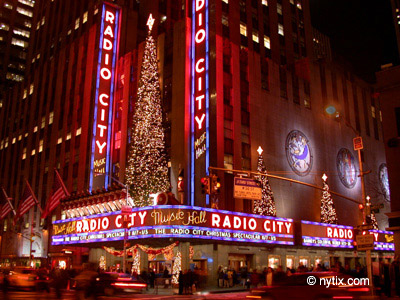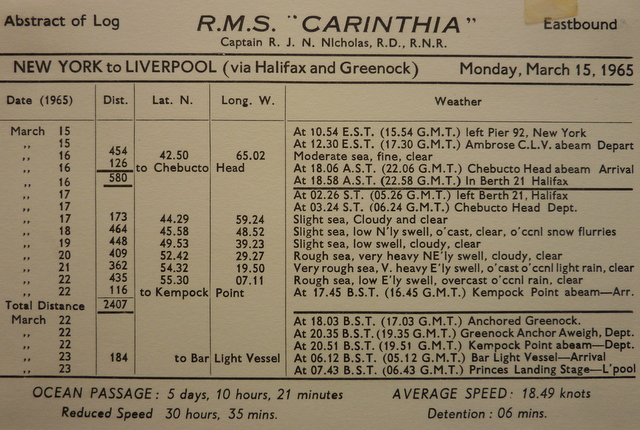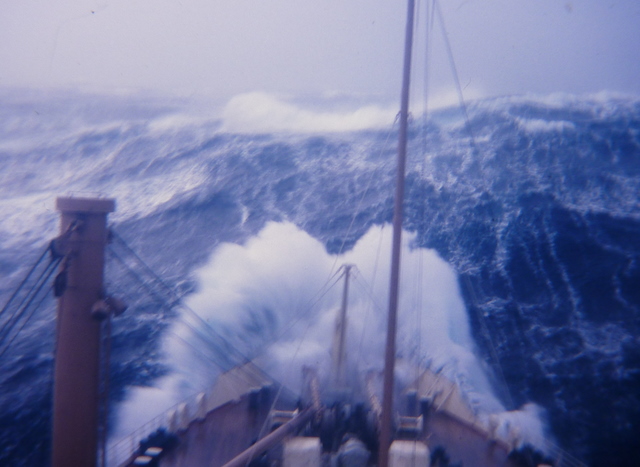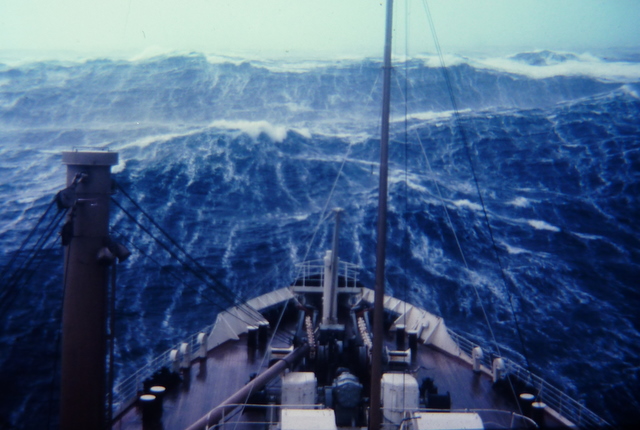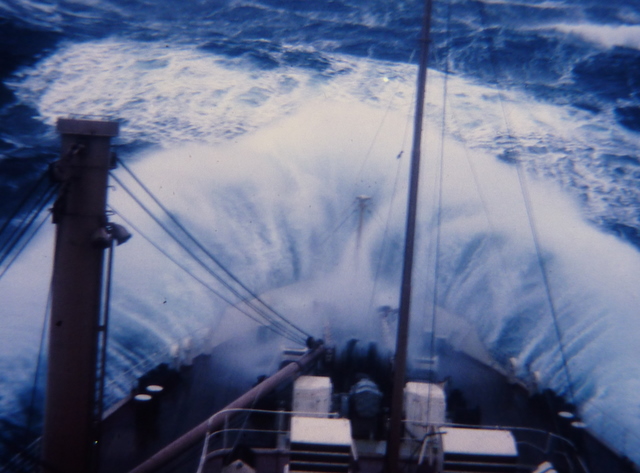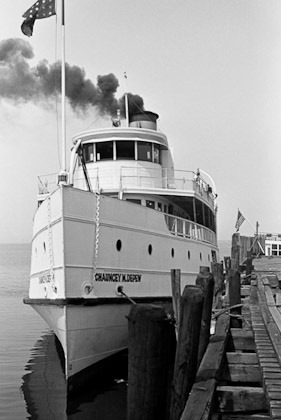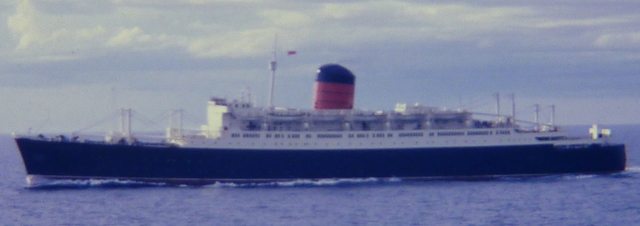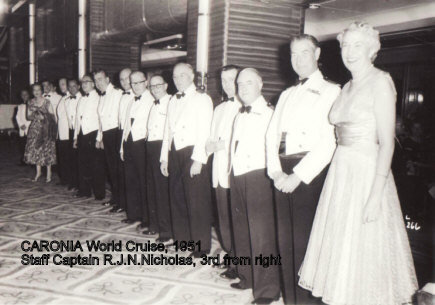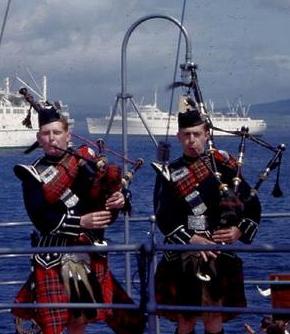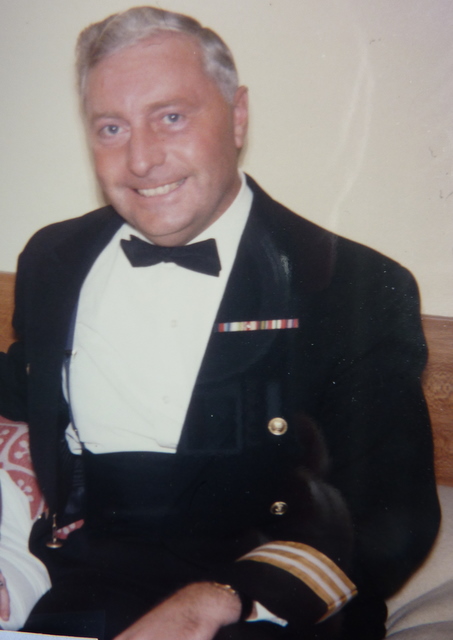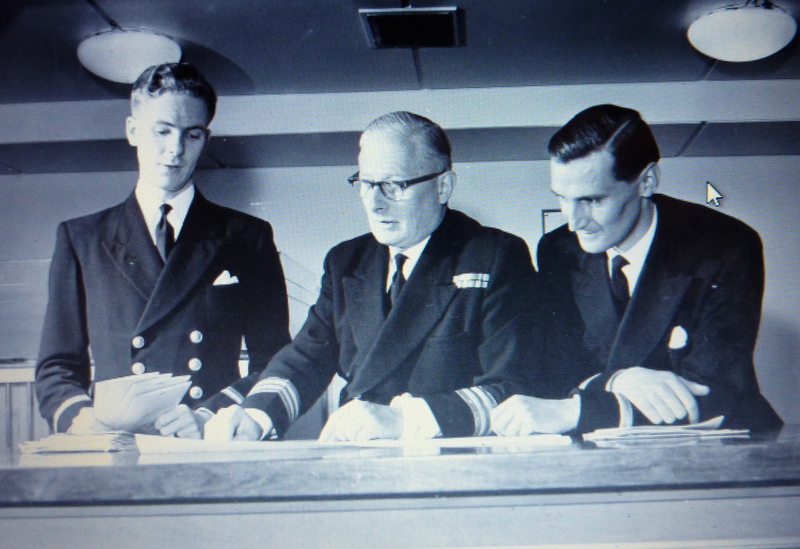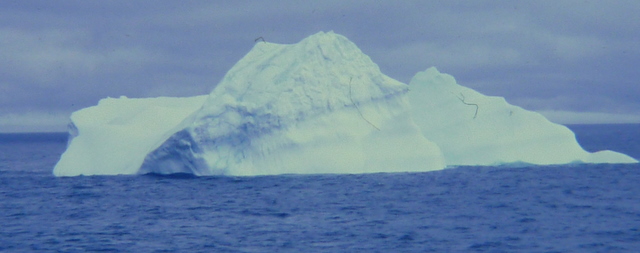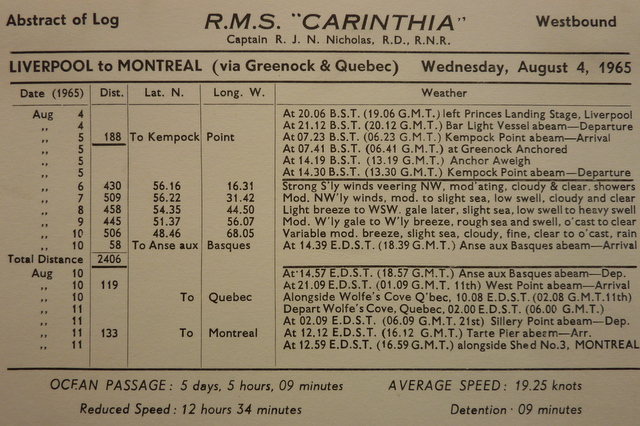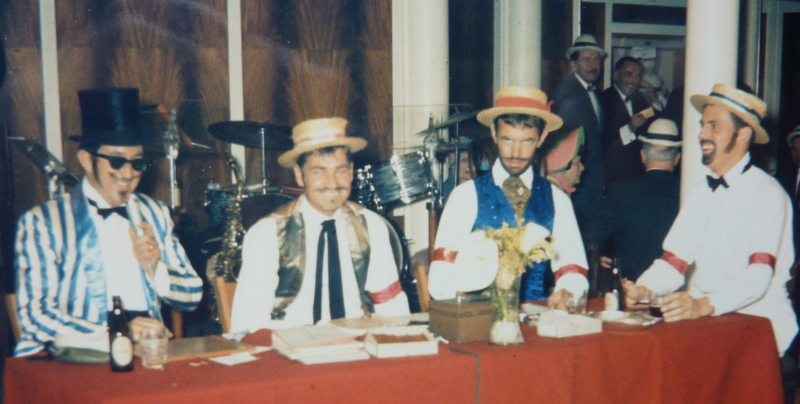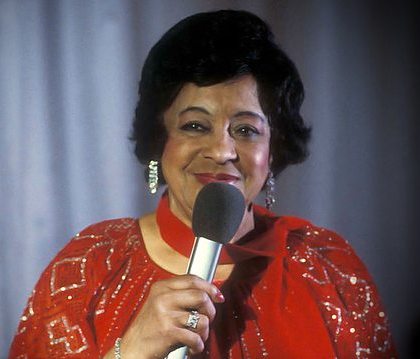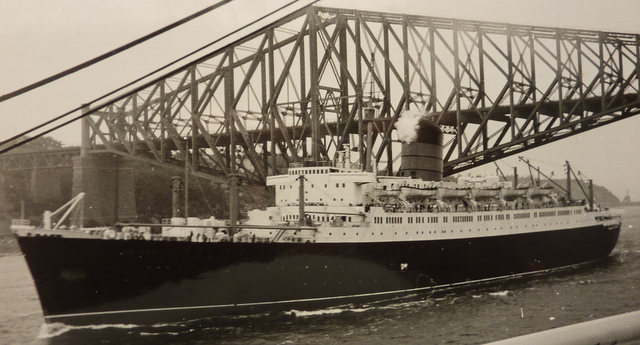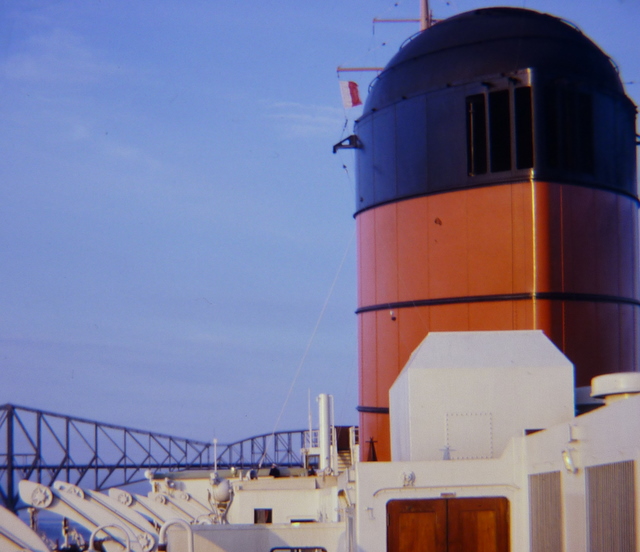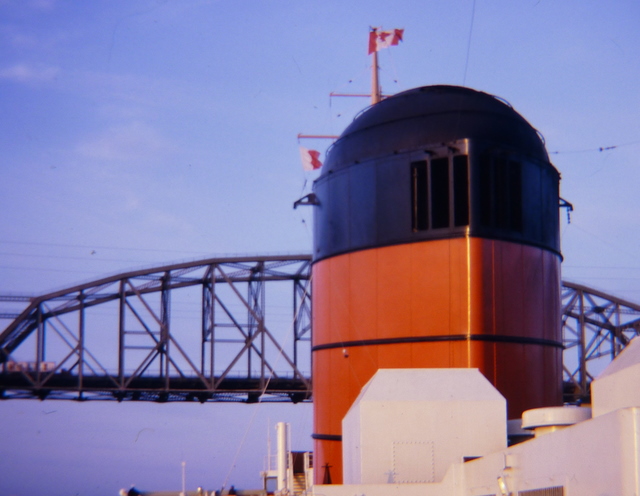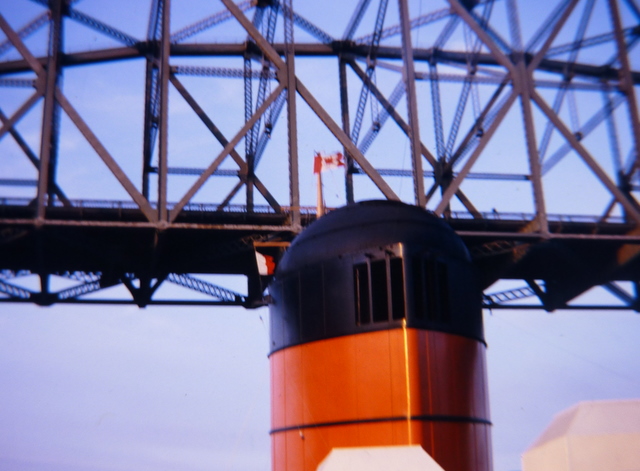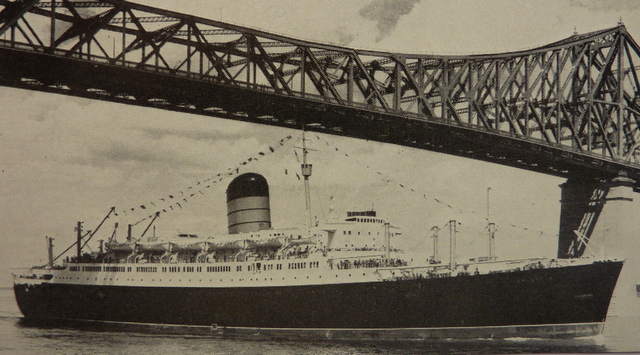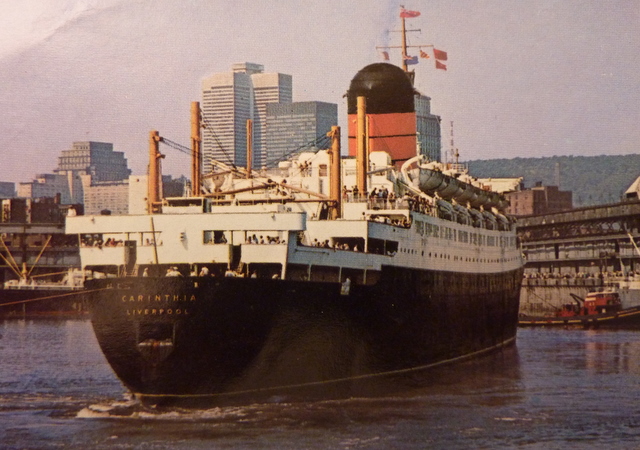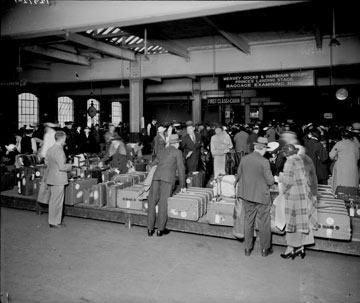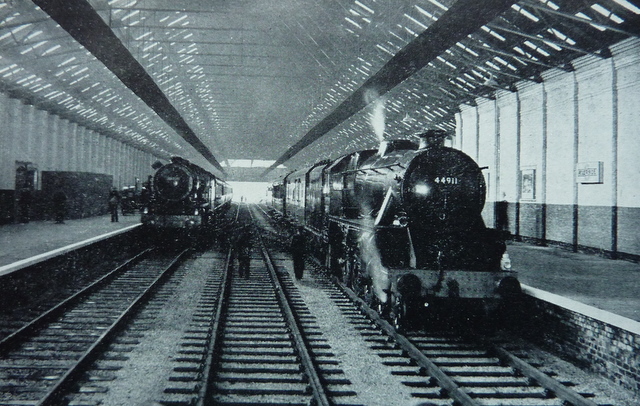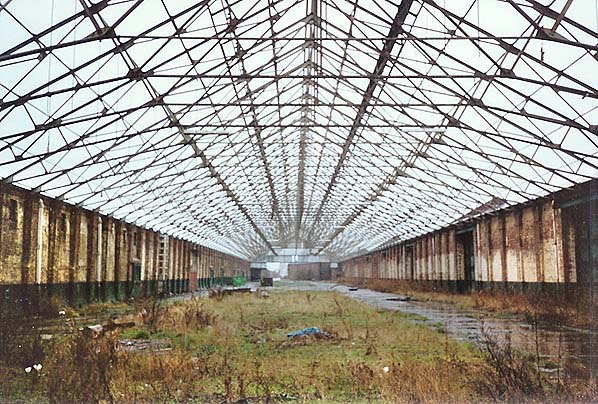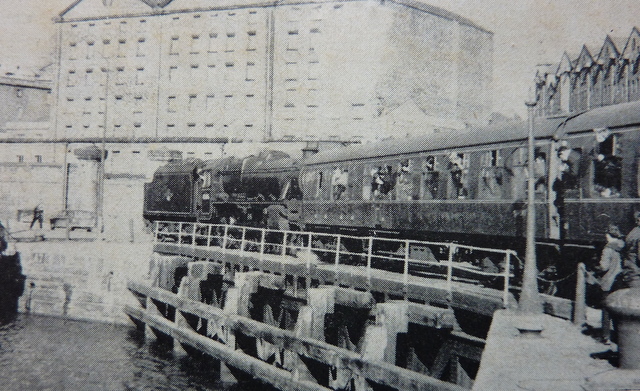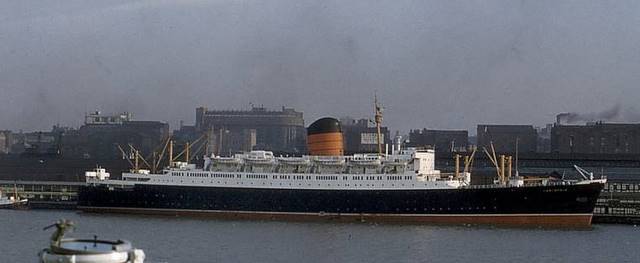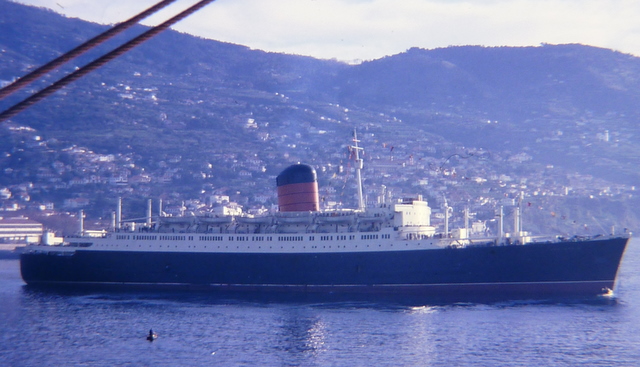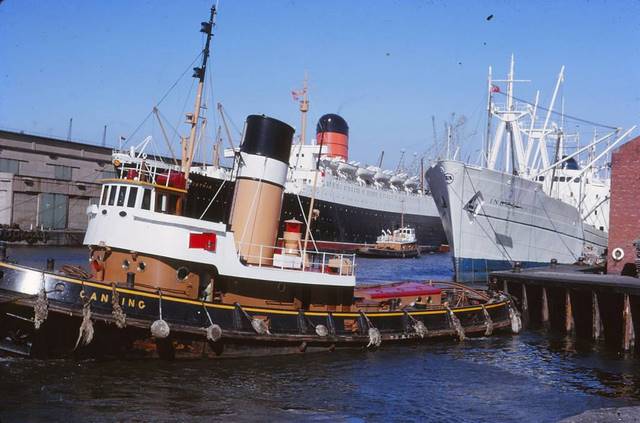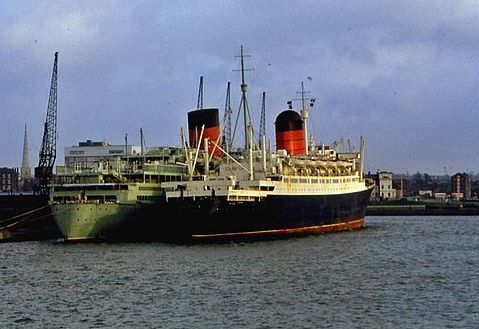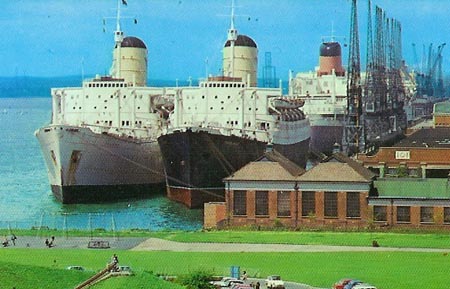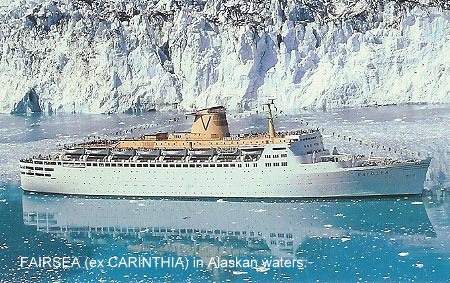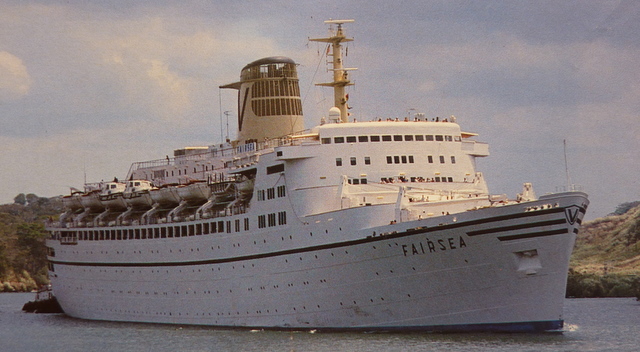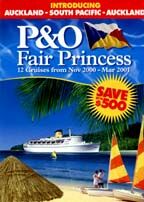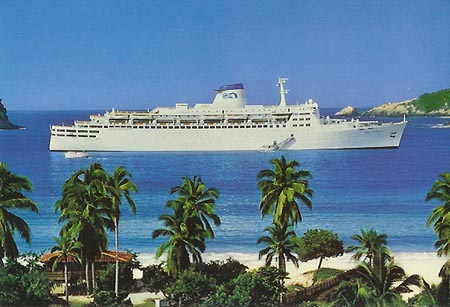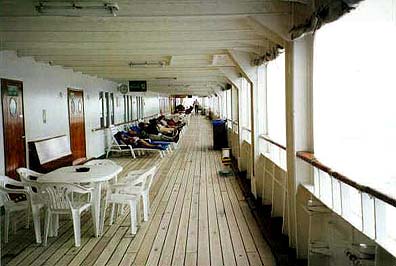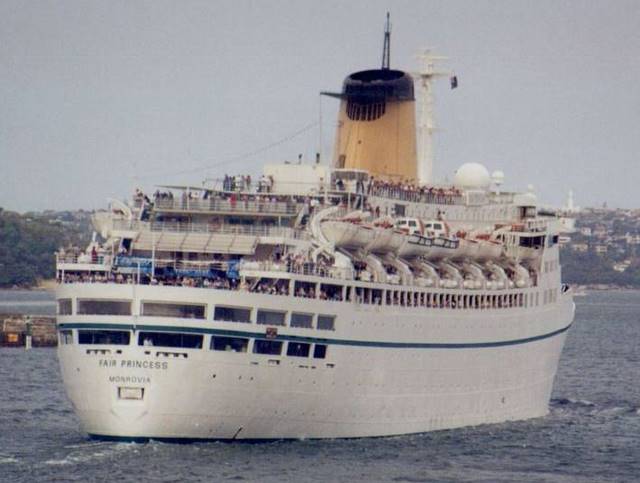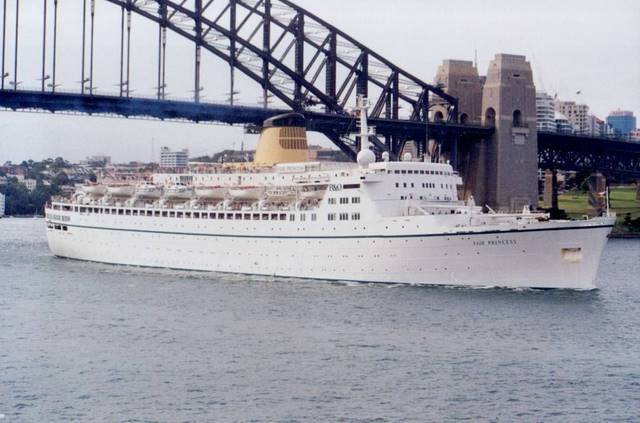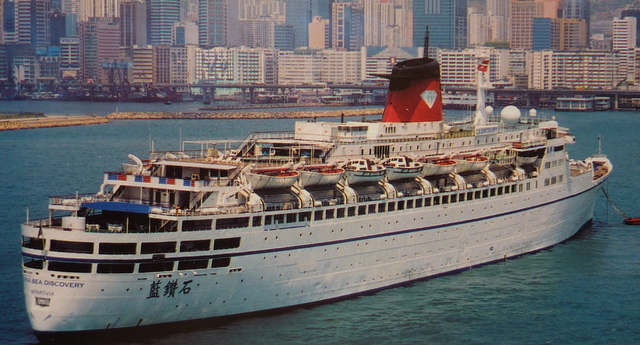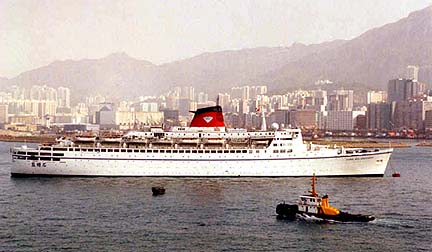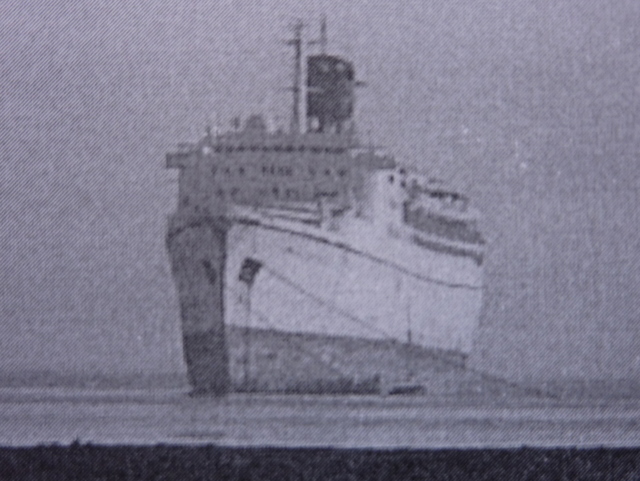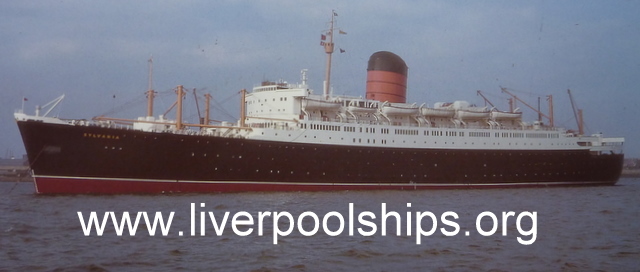CARINTHIA
The CARINTHIA of 1956 was the third of a quartet of new ships built for the Cunard Line and specially designed for the Canadian service
The CARINTHIA at anchor off Princes Landing Stage at Liverpool ___________________________________
Built by John Brown & Co. Ltd. at Clydebank. Yard No: 699 Official Number: 187137 Signal Letters: G V D Q Gross Tonnage: 21,947 Nett: 11,630 Length: 608.3ft Breadth: 80.4ft Owned by the Cunard Steamship Company Limited. Registered at Liverpool 4 steam turbines, double reduction gearing to twin screws _________________________________________________
Towards the end of 1951 the Cunard Line announced that it would build a completely new class of liner for the Liverpool - Montreal service. Initially the order was for two ships, but this was later increased to four. The new liners would be the largest ever built for the Canadian service. However, even whilst the first two ships, the SAXONIA and the IVERNIA, were under construction, some airlines were formulating plans for trans-Atlantic services. Nevertheless, the Cunard directors remained convinced that for the foreseeable future there would always be sufficient people who would wish to travel by sea and to keep the fleet of liners viable.
The basic design of these new ships combined a large passenger capacity with space for a substantial amount of cargo - all within the maximum dimensions which would permit safe navigation of the St Lawrence up to the terminal port of Montreal. The ships would be able to carry 125 passengers in first class and 800 in tourist class. There was a cargo capacity of 300,000 feet, including 15,000 cubic feet of refrigerated space. Denny-Brown stabilisers were fitted.
All the first-class cabins had private facilities, but the vast majority of tourist-class passengers had to make do with shared toilet and bathroom facilities. For brand-new ships in the 1950s, on a principal liner route, this showed a remarkable lack of forward thinking. Air-conditioning in the new ships was very partial, extending only to the public rooms. Not one of the passenger cabins, and certainly nowhere in the crew's quarters, was air-conditioned.
However, as these new ships entered service between 1954 and 1957, they were hailed by the shipping press as a 'brilliant quartet'.
The CARINTHIA at anchor off the Pier Head at Liverpool in 1959
The order for the third ship of the 'brilliant quartet' which was to become the CARINTHIA had been confirmed with John Brown at Clydebank in 1953. Princess Margaret agreed to launch the new ship and this took place on 14th December 1955, a rain-swept day, but in Princess Margaret's own words 'A happy and brilliant occasion'. Some 20,000 spectators braved the weather to watch the launch.
The CARINTHIA immediately before her launch
Princess Margaret described the launch as a 'happy and brilliant occasion'
The CARINTHIA enters the waters of the River Clyde
The British Pathe newsreel footage of the launch of the CARINTHIA can be viewed at:
www.britishpathe.com/video/carinthia-launched
The SAXONIA and the IVERNIA had both been criticised for their interior modern decor, so the CARINTHIA returned to more traditional style. On 5th January 1956 a contributor to the Architect and Building News wrote: 'The Cunard Line has a wonderful record for seamanship, service and naval architecture, but an abysmal one for interior decoration'.
The first-class restaurant. The chairs are from the AQUITANIA
The first-class smokeroom on the promenade deck forward
A first-class stateroom
The first-class lounge
The tourist-class smokeroom, known as 'The Beaver Club'
The tourist-class restaurant
The tourist-class lounge
The cinema, which was used by both first-class and tourist-class passengers. First class had the use of the balcony, whilst tourist class sat in the cinema stalls.
A typical 4-berth tourist-class cabin. Agility was certainly needed to gain access to the upper berth, especially in rough weather. There were no private toilet and bathroom facilities, and there was no air-conditioning. It got very hot in the summer months, especially in the inboard cabins with no porthole.
The new CARINTHIA left John Brown's yard on 12th June 1956 for her trials which were run over the Arran Mile. Whilst undertaking these speed trials she passed and exchanged greetings with the inward-bound IVERNIA. The master of the IVERNIA, Captain McKellar, transferred to the CARINTHIA for her maiden voyage. At a luncheon held on board the CARINTHIA at the time of her handover from her builders, Mr F.H. Dawson, the general manager of the Cunard Line, indicated that the SAXONIA and the IVERNIA would in future use Southampton as their terminal port in the UK.
The CARINTHIA returning up the Firth of Clyde after successfully completing her trials over the Arran Mile.
The CARINTHIA left Liverpool on 27th June 1956 with over 800 passengers on her maiden voyage from Liverpool to Montreal. Shortly afterwards Cunard announced that the stalwarts of its Canadian service in post-war years, the FRANCONIA and the ASCANIA, would be withdrawn from service in October 1956, to be followed by the SCYTHIA a year later.
The CARINTHIA alongside Princes Landing Stage, Liverpool ready to sail on her maiden voyage on 27th June 1956
In January 1957 the CARINTHIA sailed on a cruise from New York to the Caribbean. It was not a success due mainly to the very partial air-conditioning installed in the new liner, just one feature which made her unsuitable for extensive cruising in her later years with the Cunard Line.
In 1957 the Cunard Line was operating a fleet of 12 passenger liners
In April 1959 the CARINTHIA damaged her starboard propeller in the ice at Montreal, and she had to enter dry dock to have this changed at Liverpool at the end of the voyage.
The CARINTHIA encountering an ice-jam in the St Lawrence
A post-war record of 115 trans-Atlantic liner calls at Greenock was scheduled for 1960. Fifty-one of the visits were scheduled for Cunard liners, with the CARINTHIA and SYLVANIA making a total of forty calls. The MEDIA and the PARTHIA were also scheduled to anchor at the Tail of the Bank, and the IVERNIA would be there on two occasions.
Two of the CARINTHIA's popular masters in the late 1950s. Left: Captain D.M.Mclean; right: Captain A, MacKellar
The Canadian Government chartered the CARINTHIA for six weeks commencing in November 1960 for trooping voyages.
During her winter overhaul in January 1961, the CARINTHIA became caught up in the strike of Amalgamated Engineering Union members which trapped her in dry dock for some sixteen weeks. When this strike was over the boilermakers who had been laid off the CARINTHIA commenced a threatened embargo of all Cunard vessels using Liverpool. This was the same industrial action which spelt the end of Cunard service for the MEDIA and the PARTHIA. When the CARINTHIA eventually left the dry dock it was found that much of her interior woodwork had warped as a result of the unusual stresses placed on the ship for so long, and joiners were hard-pressed to make her serviceable again as hundreds of doors had to be planed and re-hung.
The CARINTHIA in the Sandon Basin at Liverpool, awaiting the time to lock-out into the River Mersey, before embarking passengers at Princes Landing Stage.
It was not until 1st June 1961 that the CARINTHIA sailed from Liverpool on her first voyage of the year with 260 passengers bound for Quebec and Montreal.
Shortly after re-entering service the CARINTHIA collided with the Canadian vessel TADOUSSAC on 30th August 1961 in thick fog some 30 miles upstream from Quebec, on passage to Montreal. A head-on collision was very narrowly averted. No casualties were reported.
The CARINTHIA was once again caught up in the turbulent industrial relations of the late 1950s and early 1960s, becoming strikebound from 19th April until 31st May 1962.
In January 1964 the CARINTHIA left Liverpool for New York on a voyage which included a call at Bermuda. She had on board just 260 passengers and 1,800 tons of cargo. On her return eastbound voyage she carried 480 passengers and a mere 250 tons of cargo. Considering that the ship had a capacity for 868 passengers and 7,000 tons of cargo, these statistics must have been a sure indication to the Cunard Line of just how inappropriate was the design of these liners.
The CARINTHIA alongside the Landing Stage at Liverpool Pier Head
Towards the end of 1963 the Cunard Line upgraded eighty tourist-class cabins on the CARINTHIA and provided them with private bathrooms. Considering that there were 250 tourist-class cabins in all, this was very much a token gesture and was too little, too late. Given the success of the transformation of the SAXONIA and IVERNIA into the CARMANIA and the FRANCONIA, it seemed that Cunard was either unwilling or unable to rebuild the CARINTHIA and the SYLVANIA. They remained principally emigrant carriers.
A group of Purser's Department staff on the CARINTHIA, photographed in November, 1964. Left to right: Orchestra Leader Arthur Plant; Purser's Clerk Roy Elwood; Crew Purser Steve Gregson; Mrs Gregson; Chief Purser Peter Dawes; Tourist Purser John Lecoustre; Unknown passenger; Lady Assistant Pursers Shirley Thomas and Mavis Burns; Junior Assistant Purser Peter Jones and Chief Printer Jack Newman. ____________________________________________________________ A gallery of photographs of Cunard Pursers Staff from the 1960s is available to view on Flickr. Go to the Flickr Home Page, type < cunardpursers1960s > into the search box and click 'search'. There are 26 photographs taken on various ships. ____________________________________________________________
The CARINTHIA remained on her designed route from Liverpool and Greenock to Quebec and Montreal all her working life in the Cunard fleet. In the winter months, from December to March, the terminal ports were Halifax, N.S. and New York. She very rarely called at Southampton - just very occasionally in the winter months. The CARINTHIA was the workhorse of the Cunard fleet in the early 1960s. When the other seven units of Cunard's passenger fleet went cruising, the CARINTHIA alone remained on the North Atlantic operating a skeleton service with, it has to be admitted, very few passengers.
Left: the CARINTHIA leaving Montreal on the last sailing of the St Lawrence season in November 1964; and right: the same scene eight weeks later with the St Lawrence in the grip of winter.
~~~~~~~~~~~~~~~~~~~~~~~~~~~~~~~~~~~~~~~~~~~~~~~~~~~
To give some idea of life on board the CARINTHIA, the following article describes the winter of 1964/1965, plus the St Lawrence sailings of the 1965 summer:
A YEAR WITH THE 'CARINTHIA'
by John Shepherd (Assistant Purser on the CARINTHIA, 1963 - 1967)
part 1 : WINTER NORTH ATLANTIC
The CARINTHIA sailed from Liverpool on Saturday 19th December 1964 on a voyage to Halifax, N.S. and New York. This would entail spending Christmas Day at sea and arriving at Halifax on Boxing Day morning. After a short stay of three hours in the Nova Scotian port, the CARINTHIA sailed for New York where she berthed at Pier 92 on the evening of Sunday 27th December. Pasenger numbers were low and the weather was foul.
The somewhat lacklustre entertainments programme on the CARINTHIA for Christmas Day, 1964
On arrival at New York the CARINTHIA took her pilot at the Ambrose Channel Light Vessel and then proceeded to the quarantine anchorage off Staten Island, just beyond the newly completed Verrazano Narrows Bridge. Here the port officials boarded by tender; these included the Port Health, U.S. Immigration and U.S. Customs. Overseeing all this was Cunard's New York representative, Tom Luby.
This gave about ninety minutes of leeway whilst the CARINTHIA sailed across New York Bay, up the North River, and berthed alongside Cunard's time-honoured Pier 92. Passenger immigration procedures were generally just about complete as the CARINTHIA berthed alongside, and it only remained for the hold baggage to be discharged and cleared through Customs before the passengers could proceed on their way.
The CARINTHIA alongside Pier 92 at New York
Not so the crew. U.S. Immigration insisted on a complete muster. All officers and crew were required to present themselves at the crew purser's office with their Seamen's Identity Card. One young lad appeared at the office with his documents and was asked by the Immigration Officer: "Are you a commy?" "Yes", replied the lad, "for the last two voyages." It took some explaining to the officer that the lad in question was a commis waiter, and not a member of the communist party! Humour was in very short supply amongst members of the U.S. Immigration staff! Remember, McCarthyism and communist witch-hunts were still very recent back in 1964.
~~~~~~~~~~~~~~~~~~~~~~~~~~~~~~~~~~~~~~~~~~~~ STABILISERS FOR ALL !!
From a letter received at the Cunard Line passenger department in 1959:
"I would prefer to sail on the CARINTHIA and if you will be good enough to let me know if stabilisers apply to the whole of the vessel (tourist accommodation as well as first class), and if I can take my cat on this vessel, then I shall be very pleased to make a firm booking."
~~~~~~~~~~~~~~~~~~~~~~~~~~~~~~~~~~~~~~~~~~~
The CARINTHIA lay at New York from Sunday evening 27th December 1964 until Saturday afternoon 2nd January 1965. A boat drill was held, but as the dock was full of pack ice there was no chance of lowering the boats into the water. So, for six days, the 400+ members of the CARINTHIA's crew were on full pay with virtually nothing to do. Their time was their own and with Broadway and 42nd Street just a five minute, 25-cent bus ride away, they made the most of it. A visit to the world-famous Radio City Music Hall to see the Christmas Show was a 'must', and there was a once-in-a-lifetime opportunity to be in Times Square to see in the New Year. Basic victualling was provided on board, but many of the crew preferred to cross the dock road, which ran underneath the West Side Elevated Highway, to the Market Diner, that well known haunt of Cunard crews whilst in New York.
The Market Diner at New York - foot of West 52nd Street and just across the road from Cunard's Pier 92.
The interior of the Market Diner, the popular 'haunt' of Cunard crews, at the foot of West 50th Street, New York.
A visit to the world-famous Radio City Music Hall in New York was a 'must' during the long port period alongside Pier 92.
As the CARINTHIA had been at sea on Christmas Day, the tradition of 'Crew Christmas Dinner' took place during the layover in New York. The galley staff prepared roast turkey with all the trimmings, and this was served to the crew in the tourist restaurant by the ship's officers who were also required, at their own expense, to provide seemingly endless pints of beer to slake the thirst of the crew they were serving. There was also a crew concert one evening in the tourist-class lounge, where various crew members displayed their previously unseen or unheard talents.
Times Square was just a five minute, 25-cent bus ride from Pier 92. This photograph was taken in 1963.
The return passage to Liverpool left New York on Saturday 2nd January 1965 and, following a call at Halifax the next day, the CARINTHIA was back in Liverpool on Sunday 10th January. Once again passenger numbers were very low, particularly in first class, where just twenty-two were carried.
After five days in Liverpool, the CARINTHIA was off to New York again on Friday 15th January, but this time Cobh was substituted for Greenock. The CARINTHIA was at anchor in Cobh harbour by ten the following morning. After boarding the ship from the pilot launch and bringing her to a safe anchorage, the Cobh pilot had a chat with the CARINTHIA's master and it was decided that it would not be safe, due to deteriorating weather, for him to disembark to the launch after taking the CARINTHIA back to sea. The pilot would therefore remain on board and make the round voyage to New York.
After this decision had been taken, and it seemed to be taken on a very regular basis whether the conditions were deteriorating or not, the pilot would go ashore in his launch, collect a suitcase with clothes for the voyage and presents for all his friends and relations in the United States, and then return on board in time to pilot the CARINTHIA out of the harbour. The Cobh pilot was assigned a first-class cabin and was signed on the ship's articles as 'supernumerary'.
Abstract of Log for a typical eastbound winter passage from New York to Liverpool
The one deviation which took the CARINTHIA to the sun occurred on the following voyage. Each year the Cunard Line scheduled one of its liners to call at Bermuda in early January on an outward sailing from the U.K., and about six weeks later there would be another call by a homeward bound vessel. The purpose of these calls was to allow wealthy Brits to spend the worst of the winter in Bermuda and to travel out and home by Cunard. In 1965 the CARINTHIA was scheduled to make a call at Bermuda on Wednesday 24th February. She left New York on Monday 22nd February and sailed into truly atrocious weather whch delayed her by eighteen hours.
Extreme rough weather photographed through the 'Kent' clear-view screen from the CARINTHIA's wheelhouse. (Photos: John Shepherd)
The approach to Bermuda is tricky and can only be attempted in daylight, The CARINTHIA arrived at the pilot station at the Five Fathom Hole at first light on Thursday 25th February and commenced the 20-mile passage to the anchorage at Grassy Bay in the Great Sound. Here she was met by the ancient CHAUNCEY M. DEPEW, which took the transit passengers ashore for a few hours in the sun. The 'Chauncey' was back alongside the CARINTHIA by 3.30pm with the returning 'wealthy Brits' and sailed immediately so as to be clear of the approach channel before darkness.
The Bermuda tender CHAUNCEY M. DEPEW
The approach to Bermuda is difficult and can only be attempted in daylight. This photograph is taken from the FRANCONIA as she approaches Hamilton through the 'Two Rock Channel'
Among the 'wealthy Brits' were some of the regulars who made this voyage every year, such as Sir Humphrey de Trafford and his wife. Sir Humphrey was a well known race horse owner in the early 1960s and regularly named his horses after Cunard liners, such as MEDIA and PARTHIA. Wilfrid Brambell, the star of 'Steptoe and Son', a popular 1960s' television comedy, was on board, as were the Graesser-Thomas family. Mr Graesser-Thomas was chairman of the company which brewed Wrexham lager, the beer which was supplied to the CARINTHIA and the SYLVANIA. He always bought the entire crew a pint whenever he travelled. The crew were, in fact, not overly impressed with Wrexham lager, and the story goes that just before sailing from Liverpool one voyage they sent a sample ashore for analysis. On arrival back at Liverpool the analyst's report was waiting: "This horse is unfit for further work," it read. Well, it's a good story!
After a final round voage to New York, the CARINTHIA was back in Liverpool on 23rd March 19l65, ready to commence her regular run to Quebec and Montreal.
The CARINTHIA at full speed in mid-Atlantic, photographed from the SYLVANIA
A YEAR WITH THE 'CARINTHIA'
part 2: 'Summer on the St Lawrence'
The CARINTHIA alongside her berth in Liverpool's Huskisson Dock
The CARINTHIA's berth at Liverpool was in the Huskisson Branch Dock After disembarking passengers at the Princes Landing Stage, the liner would anchor in the Mersey awaiting the tide to enter the Sandon half-tide dock, and from there she would be towed to her berth. The schedule involved arriving at Liverpool on Fridays. The weekend in dock was a quiet time and with the ship shut down there was no catering on board, and any officers and crew on stand-by were paid a subsistence allowance to obtain their own meals.
The CARINTHIA in the Sandon half-tide dock at Liverpool
Sailing day on the Canadian service from Liverpool was Wednesday, with departure time set for 8.pm. The CARINTHIA would arrive alongside the landing stage at 4.pm, ready to embark her passengers and their hold baggage.
The regular master of the CARINTHIA in 1965 was Captain R.J.N. Nicholas. One of his chief delights in life was blowing the ship's whistle. Promptly at 8.pm the last shore gangway was lowered and four tugs assisted the CARINTHIA away from the Princes Landing Stage. As soon as the last tug had been let-go, Captain Nicholas blew three prolonged blasts on the CARINTHIA's steam whistle, which was followed by three long blasts from the tugs, and then one short blast from the CARINTHIA. The ship moved majestically down the Mersey towards New Brighton, and here again there were three mighty blasts on the whistle, this time for the benefit of Mrs Nicholas who lived in Wallasey!
The CARINTHIA's master in the early 1960s, Captain R.J.N. Nicholas, is seen here, third from the right, when he was Staff Captain of the CARONIA in 1951
After a twelve-hour passage, the CARINTHIA would be at anchor at the Tail of the Bank, off Greenock, by nine the next morning. As soon as the anchor was down, a Clyde 'puffer' came alongside with the mail. About noon, one of the Caledonian Steam Packet Company's fleet of Clyde steamers left the quay at Greenock and brought out the passengers and their baggage. As soon as it was all on board, the CARINTHIA sailed for Quebec at about 2.pm. Once again Captain Nicholas blew three long blasts of farewell on the whistle, to the accompaniment of Scottish pipers on board the tender, playing a 'lament' on their bagpipes - "Will Ye No Come Back Again?" There wasn't a dry eye!
Sailing from Greenock to the accompaniment of Scottish Pipers playing 'Will Ye No Come Back Again?' There wasn't a dry eye !
Chief Purser Peter Dawes sailed on the CARINTHIA in the early 1960s
As the CARINTHIA rounded the Mull of Kintyre, about four hours after leaving Greenock, she began to feel the effects of the swell rolling in from the Western Ocean. The CARINTHIA was a good, if rather lively, seaboat. The Denny-Brown stabilisers were extremely effective in reducing the ship's roll, but nothing could be done about the pitching. If the swell was particularly heavy, the CARINTHIA quickly became a battleground of human misery. One of the most common sights on the first evening at sea was to catch a glimpse of the ship's nursing sisters scurrying around with trays of hyperdermic needles containing a miracle injection to stave off seasickness. It seemed to work; indeed in the words of a popular song of the period, it was 'most efficacious in every way', as a passenger at death's door at 6.pm could be seen tucking into a hearty buffet supper by 10.pm!
A group of unidentified Purser's Staff on the CARINTHIA in the late 1950s. Can anyone put names on these guys?
On the Canadian service the main weather problems were caused by fog and ice, not gales. There were certainly gales a-plenty, but they had high nuisance value only, unless they were particularly severe. There were usually many hours of fog as the CARINTHIA approached Cape Race (or, in the summer, the Belle Isle Strait) with the ship's whistle sounding in accordance with the collision regulations: one prolonged blast every two minutes, day and night. One developed a knack of sleeping through these intrusive blasts - it was only when they stopped if the fog cleared that you woke up!
An iceberg photographed from the CARINTHIA, some 200 miles to the east of the Belle Isle Strait.
Official messages from the Cunard company to the CARINTHIA at sea were sent in company code which consisted of groups of five letters, transmitted in morse code. On receipt of one of these messages, and they could be received at any time of the day or night, one of the purser's staff was detailed to decode the message using the company code book, and then to type the decode in plain language. The use of this code was a nightmare for the radio officers as just one incorrectly received letter in any one of the code groups could change the meaning of a message entirely. Similarly, all official messages from the CARINTHIA had to be coded, and then checked for accuracy. It was a laborious and time-consuming process.
Abstract of Log for a typical westbound summer crossing from Liverpool to Montreal
The purser's staff was responsible for all passenger entertainment. This was pretty basic with a few games of bingo or half a dozen 'horse races' in the lounge after dinner. Bingo needs no explanation, but the horse races involved moving wooden horses along a canvas track stretched across the dance floor. The horses were moved according to the throw of dice, and one of the lady passengers was asked to shake the dice. The lounge steward moved the horses along the track. All great fun!
A group of Purser's Staff, in fancy dress for 'Gala Night', selling bingo tickets on the CARINTHIA in 1966. Left to right they are: Brian Bibby, Alex Hunter-Robertson, Harold Hughes and John Shepherd
Adelaide Hall sailed on the CARINTHIA regularly as an 'entertainer' in the early 1960s. She was magnificent !
In the early 1960s the Cunard Line was experimenting with professional entertainers on board to provide a cabaret show three times a voyage. Some past-their-sell-by-date cabaret artists were carried to provide a song and dance routine to the music of Arthur Plant and the Orchestra. Names such as 'Boyer and Ravel', 'Flack and Lamar' and 'The Trio Vitalites' all spring to mind. In all fairness the dancers had a very difficult job keeping their feet in bad weather when the dance floor was heaving around. The one exception to this rather motley collection was Adelaide Hall, who sailed on the CARINTHIA regularly to entertain the passengers. She was magnificent.
As the voyage wore on, the CARINTHIA entered the calm waters of the Gulf of St Lawrence and proceeded to the pilot station at Father Point. The main shipping channel hugs the north shore of the gulf, and it is a highly scenic passage close in to the Laurentian Mountains. After passing the spectacular Montmorency Falls (higher than Niagara), the CARINTHIA berthed at Quebec City. Here the port officials boarded the ship and remained on board for the passage to Montreal dealing with the passenger immigration inspection en route. Passengers were not allowed to leave the CARINTHIA at Quebec - the port of entry into Canada was Montreal.
The CARINTHIA passing under the Quebec Bridge on passage to Montreal
Above series of photographs: The CARINTHIA passing under the Quebec Bridge - not much clearance!
The CARINTHIA always had a full day in Montreal (a Thursday) before embarkation for the eastbound passage on Friday morning. A full crew boat drill was held with lifeboats manned and sent away around the dock. It should be remembered that apart from two motor lifeboats, the remainder were fitted with 'Fleming Gear'. This consisted of a series of handles which the occupants of the boats pushed and pulled in order to turn the propeller.
The CARINTHIA passing under the Jacques Cartier Bridge at Montreal on her maiden arriaval in July 1956.
Sailing time from Montreal was twelve noon and the CARINTHIA would be off Quebec by seven in the evening, helped along by the river current. Here, a tender came out to meet the ship, bringing maybe another dozen or so passengers.
The CARINTHIA sailing from her berth at Shed 3, Montreal
The routine for the eastbound crossing was similar to westbound, with the exception that instead of stopping the ship's clocks for an hour each evening, they were advanced one hour at 2.am. - in effect making a twenty-three hour day.
There was the usual call at Greenock where the Liverpool pilot and the British immigration officer would join us. After clearing the Greenock passengers, he would screen the Liverpool passengers on the passage from the Clyde to the Mersey, in order to save time on arrival at Liverpool. Having the Liverpool pilot on board, the CARINTHIA did not have to stop to board a pilot at the Bar, but proceeded directly up the Mersey where she would berth at Princes Landing Stage at 6.am.
The end of another voyage - the CARINTHIA passing the Crosby Light Float in the sea channels in the Mersey approaches.
Customs examination at Liverpool for passengers leaving the CARINTHIA at the end of the voyage.
The hold baggage was immediately discharged and the passengers would be ashore by 9.am. A special train bound for London would be waiting at the Riverside Railway Station (adjacent to the landing stage) if numbers warranted it; but more often than not passengers were conveyed by bus to Liverpool's Lime Street Station.
Above: Boat trains arrive at Liverpool's Riverside Station in 1964 Below: The dereliict decaying remains of Riverside Station in 1990
An 'Ocean Liner Express' bound for London crosses the bridge over the entrance to Waterloo Dock, Liverpool, before passing through the Waterloo Tunnel to join the main line at Edge Hill.
The CARINTHIA alongside Princes Landing Stage, Liverpool
In 1966 the CARINTHIA went cruising for the first time since January 1957. Two thirteen-night cruises to the Atlantic Isles from Liverpool were organised, the first leaving on 7th January. The CARINTHIA was laid up for the duration of the 1966 seamen's strike, and for over six weeks there was no Cunard service across the North Atlantic. The strike itself proved to be the catalyst for the early withdrawal of the CARINTHIA from Cunard service, but it was by no means the only reason; the writing had been clearly on the wall almost since the ship's maiden voyage, and the 1966 strike only hastened the end.
The CARINTHIA arriving at Funchal, Madeira, on a winter sunshine cruise from Liverpool in January, 1966.
Various economies were effected, but it was all too little too late. For instance, the ship's brasswork (of which there was plenty) was painted over with white paint. The time-consuming and therefore expensive routine of polishing the brass was abandoned.
A meeting of seamen in Liverpool Docks during the 1966 strike which lasted from from 15th May until 2nd July.
The CARINTHIA was plagued by misfortune on her last round trip of the year to Canada in November 1966. Her outbound sailing was delayed for 48 hours by severe gales in the Mersey, and on her return passage she was held up by fog in the St. Lawrence. She then encountered storms in the Atlantic, described by her master, Captain H.L. de Legh, as the worst he had ever experienced. After being forced to heave-to off the Irish coast, the CARINTHIA arrived back at Liverpool thirty-six hours late.
She had sustained rudder damage which necessitated dry-docking, and it was touch-and-go as to whether she would be ready to undertake a fourteen-night Christmas and New Year cruise from Liverpool to the Atlantic Isles. In the event the CARINTHIA was ready, but the unscheduled dry-docking meant that there hadn't been time to paint her hull white, and she completed her Cunard service in her original Cunard colours, whereas all her sisters were given white hulls early in 1967.
The CARINTHIA alongside her Liverpool berth in Huskissnon Dock
The CARINTHIA was taken off the Canadian service in July and August 1967 to operate two cruises from Liverpool to the Atlantic Isles, the first sailing on 20th July, and the second on 31st July. Fares started at £60. A Cunard spokesman said: 'We expect these cruises at the height of the north-country holiday season to be tremendously popular'. These were the first mid-summer cruises from Liverpool since the LANCASTRIA operated 'guinea-a-day' cruises in the 1930s.
Given the mammoth losses which Cunard incurred as a result of the 1966 seamen's strike, Cunard's new chairman, Sir Basil Smallpiece, finally 'grasped the nettle' in October 1967 and announced the withdrawal of the CARINTHIA from Cunard service. The CARINTHIA's final voyage in Cunard colours left Southampton on 23rd November 1967 for Halifax, N.S., and she was back in Southampton on 9th December. After disembarking her passengers she was laid up alongside the CARONIA. Her Cunard days were over.
The CARINTHIA laid up alongside the CARONIA at Southampton in December 1967.
The CARINTHIA was quickly sold for a reported £1 million to the Sitmar Line on 31st January 1968. The contract of the sale prevented the CARINTHIA from sailing on any of Cunard's regular routes, or from operating cruises from UK ports.
At the time of the sale, Sitmar held the Australian Government contract for carrying emigrants from Southampton to the Dominion. Shortly after Sitmar's purchase of the CARINTHIA (and also the SYLVANIA), the contract was awarded to the Greek Chandris Line. Sitmar therefore had a problem : what to do with its two new purchases?
The CARINTHIA's name was changed to FAIRLAND, which at the time was thought to be appropriate for an emigrant carrier. However, she lay at Southampton for two years before sailing for Trieste on 9th February 1970, where she arrived on 21st February.
The CARINTHIA (still with her black hull), now renamed FAIRLAND, and the SYLVANIA (renamed FAIRWIND) laid up at Southampton in 1968 and 1969. Note the Sitmar yellow funnels.
She was berthed adjacent to the SYLVANIA and both the Cunard sisters were given a massive conversion costing some $56 million to make them 'state of the art' crusing liners. This took almost two years and the old CARINTHIA was the first to be completed. The name FAIRLAND was now considered unsuitable and was changed to FAIRSEA.
The FAIRSEA (ex CARINTHIA) cruising in Alaskan waters
The FAIRSEA (ex CARINTHIA) at Vancouver
On 3rd November 1971, almost four years after her final Cunard voyage, the FAIRSEA sailed to Los Angeles where she commenced a cruise service to Mexico. In the summer, the FAIRSEA became Sitmar's Alaska ship, and her terminal port was moved to Vancouver. In the winter months the FAIRSEA operated a Los Angeles - Panama Canal - Curacao service. The FAIRSEA and the FAIRWIND (ex-SYLVANIA), two outmoded trans-Atlantic liners, had taken Sitmar to the very pinnacle of success.
The FAIRSEA (ex CARINTHIA) in the Panama Canal
The FAIRSEA in the Gatun Locks in the Panama Canal
On 28th July 1988, P & O took over Sitmar cruises and the FAIRSEA was renamed FAIR PRINCESS. In 1993 P & O Princess Cruises issued a lavish brochure which enthused:
The FAIR PRINCESS (ex FAIRSEA, ex CARINTHIA) as she appeared after the P&O takeover of Sitmar Cruises
"The intimate FAIR PRINCESS boasts a charming, 'private-club' atmosphere that makes it easy to meet and mingle and make lasting friendships. Walnut-panelled walls, gleaming stainless steel rails, luxuriously thick carpet, butter-soft leather, reflective ceilings, etched glass doors and distinctive artwork all evoke seagoing traditiions. This classic ship is packed from stem to stern with fabulous amenities - the FAIR PRINCESS is an uncommon delight!"
Fancy ! Could this really be the old CARINTHIA ?
In early 1995 Princess Cruises sold the FAIR PRINCESS to Regency Cruises. Before the sale had been finalised, Regency Cruises had collapsed financially. The result was the P & O / Regency Cruises was left with a ship it did not want. The FAIR PRINCESS was laid up at Mazatlan, Mexico, and in the summer of 1996 P & O announced that she would replace the FAIRSTAR (ex OXFORDSHIRE) on cruises from Australia.
The FAIR PRINCESS (ex CARINTHIA) at Sydney
The FAIR PRINCESS sailed on her first cruise from Sydney on 7th February 1997, fully booked with 1,050 passengers on board. She was described as having 'a classic liner exterior and excellent sea-keeping qualities' suited to the South Seas. However, many of the FAIRSTAR's regular passengers were unhappy, referring to the FAIR PRINCESS as 'an old lady in her dotage'. There was a series of small mishaps on this first cruise - minor fires, burst pipes, defective lights etc. On 27th February 1998, with a full complement of passengers on board, all four of the FAIR PRINCESS's generators failed, necessitating the cancellation of the cruise. In July 1999, bad publicity dogged the ship. Three of her passengers had gone down with typhoid fever. However, one travel writer enthused that 'the FAIR PRINCESS was Australia's most popular cruise ship'.
The FAIR PRINCESS in an idyllic cruise location
A surprise announcement came from P & O on 19th June 2000 to the effect that the sale of the FAIR PRINCESS had been negotiated earlier than expected, and that her entire cruise programme would be cancelled after November 2000.
The promenade deck on the FAIR PRINCESS, port side, looking aft. Although the glass screening has been removed, this deck is very much the same as during the ship's Cunard days on the Western Ocean.
The following day a press release was issued by The Great Canadian Gaming Corporation stating that it had acquired a 25% interest in the FAIR PRINCESS. The ship would be based in the South China Sea to service the medium and short-haul cruise ship and entertainment market.
The FAIR PRINCESS leaving Sydney
The FAIR PRINCESS's final months of cruising for P&O were not without incident. In early August 2000 there were four cases of pneumonia on board, and there were persistent rumours of Legionella bacteria. Nevertheless, the FAIR PRINCESS received a clean bill of health when she arrived back at Sydney to take up duties as a hotel ship to provide accommodation for visitors to the Olympic Games.
The FAIR PRINCESS left Sydney for the last time on 15th November 2000 following her final P&O cruise, and arrived at Hong Kong on 29th December. Following a survey by passenger safety inspectors, a list of defects running to seven pages was produced, all of which had to be made good.
In February 2001 the ship was renamed CHINA SEA DISCOVERY. The intention was to use her on gambling cruises out of Hong Kong at weekends, and to operate cruises between Haikou on Hainam and Halong Bay in Vietnam.
The CHINA SEA DISCOVERY (ex FAIR PRINCESS, ex FAIRSEA, ex CARINTHIA)
Having finally obtained her passenger safety certificate, the CHINA SEA DISCOVERY was far from successful. She often had less than twenty passengers on board for her overnight gambling cruises from Hong Kong. It was said that many Hong Kong based gambling ships had their names changes quite regularly because of the superstitious nature of their gambling passengers!
By June 2001 the CHINA SEA DISCOVERY was laid up at Kaohsiung, Taiwan, while her owners tried to find a way of breaking into the lucrative Asian cruise market. One rumour circulating at this time had it that the ship would be chartered by the German travel organisation Phoenix Reisen, and sail in tandem with the ALBATROS (ex SYLVANIA). However, the managing director of Phoenix Reisen scotched this rumour and was quoted as saying: "One ALBATROS is quite enough for us!"
The CHINA SEA DISCOVERY at Hong Kong
In the event the CHINA SEA DISCOVERY returned to Hong Kong and by 2003 she was in near derelict condition. After two more years of lay-up she was sold for scrap, and on 20th November 2005, fifty years almost to the day after her launch, and now renamed SEA DISCOVERY, she arrived at Alang, India for demolition.
That was not quite the end of the story of the Cunard liner CARINTHIA, for on 17th February 2006 a serious fire broke out in the engine room of the beached and partially dismantled ship, trapping nine demolition workers in the hull. The fire left the remains of the former CARINTHIA a charred hulk from stem to stern.
The final resting place of the former Cunard liner CARINTHIA, on the beach at Alang, India in January 2006.
By way of conclusion, it is interesting to note that all four SAXONIA sisters, Cunard's 'brilliant quartet' of the 1950s, were all built by John Brown at Clydebank, and all met their end on the beach at Alang.
~~~~~~~~~~~~~~~~~~~~~~~~~~~~~~~~~~~~~~~~~~~~~~~~~~
~~~~~~~~~~~~~~~~~~~~~~~~~~~~~~~~~~~~~~~~~~~~~~~~
|



